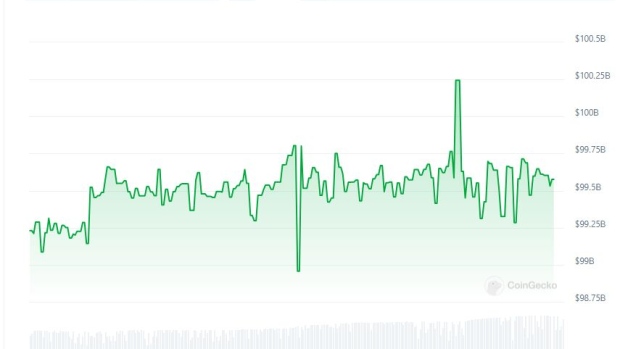Mar 4, 2024
Tether’s Stablecoin Briefly Tops $100 Billion in Circulation for the First Time
, Bloomberg News

(Bloomberg) -- Tether Holdings Ltd.’s USDT token briefly surpassed $100 billion in circulation for the first time, marking a major milestone for the world’s largest stablecoin.
USDT, a cryptocurrency which aims to maintain a one-to-one value with the US dollar, is the first stablecoin to reach such size. Circulation of USDT has risen more than 9% since the start of the year, according to data from CoinGecko, bolstered by rising demand for Bitcoin which is trading at its highest value in more than two years. Tether is the world’s most-traded cryptocurrency.
Tether briefly reached $100.2 billion in circulation at around 8:10 a.m. in London on Monday, CoinGecko data showed, before dropping back to around $99.6 billion. The token’s value also temporarily traded above $1. Spokespeople for Tether didn’t immediately respond to a request for comment.
Stablecoins, a form of crypto token pegged to another asset, use reserves to support their value. They are integral to the way crypto markets operate, acting as a less volatile alternative for traders looking to swap between digital assets and to store their wealth.
Tether’s stated reserves for its USDT stablecoin grew to $97 billion in December — more than 76% of which sat in short-dated US Treasury bills, according to an attestation published in January. Rising yields on such assets have significantly boosted Tether’s profitability over the past year.
Read more: Tether Says Profit Rose to a Record During Crypto Market Rebound
The issuer’s pile of excess capital stood at $2.85 billion in December, the firm said earlier this year, having spent some of its cash on investments in areas such as industry research and Bitcoin mining. It plans to expand further in those areas in 2024, Tether Chief Executive Paolo Ardoino said in an interview in November, allocating around half a billion dollars to funding Bitcoin mining activities alone.
Distant Competition
Tether’s market share is far larger than any of its rivals. It presently makes up around 70% of the $142 billion stablecoin sector, according to DeFiLlama data, while its next closest competitor Circle’s USDC sits at 19.4%.
That makes Tether one of crypto’s most influential businesses, with its product powering the activities of crypto companies and retail investors alike. Still the token issuer has also found itself at the center of public controversy and regulatory scrutiny due to a perceived lack of transparency over its reserves and corporate structure.
Tether paid more than $40 million to settle allegations by a US watchdog in 2021 that it had lied about the assets inside its collateral pile. The company began publishing quarterly attestations of its reserves with a third-party accounting firm that year, which serve as a time-limited snapshot into its holdings rather than a full audit.
It has also been under fire over USDT’s use in terrorism financing and human trafficking, particularly in Asian markets. Organized crime groups in China utilize the stablecoin in illegal betting operations, according to a January report by the United Nations Office on Drugs and Crime.
The TRON blockchain, which hosts the largest supply of Tether tokens globally, “has become a preferred choice for crypto money launderers in East and Southeast Asia due to its stability and the ease, anonymity, and low fees of its transactions,” the report said. Responding to the document, Tether said it was committed to combating the criminal use of cryptocurrencies.
--With assistance from David Pan.
©2024 Bloomberg L.P.





